More than 700 scientists from 45 countries joined Februray 22-26 in Münster for discussing the progress in analytical methodologies using plasma sources.
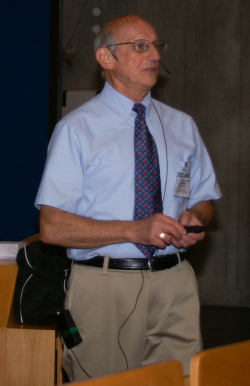
Ramon Barnes giving a short course on
Fundamentals of ICP Spectrometry
|
In its 30th year the EWCPS came back to Germany for the third time after
1991 (Dortmund) and 2003 (Garmisch-Partenkirchen). The meeting
organized joinly by Prof. Uwe Karst (University of Münster), EVISA
Director Michael Sperling and Martin Vogel (University of Münster) attracted more than 700 participants, the
highest number during the last 15 years.
The EWCPS started on Sunday afternoon with six short courses given by renowned experts in the field that were registered by about 200 participants. The short courses covered also some of the hot topics of the conference, namely "Fundamentals of Plasma Spectrometry" by Ramon Barnes, "Direct Analysis with Ambient Mass Spectrometry" by Jake Shelley and Carsten Engelhard, "Isotopic Analysis" by Frank Vanhaecke, "Elemental Bio-Imaging" by Philip Doble , "Glow Discharges" by Gary Hieftje and "ICP-MS for Bioanalysis" by Maria Montes-Bayon.
The main conference was then opened with welcoming words by the organizers assisted by the brass ensemble Blechgewand(t). The scientific program started immediately afterwards with two plenary lectures presented by Gary Hieftje (Advances in and Alternatives to the ICP for Atomic Emission Spectrometry) and Uwe Karst (Speciation Analysis and Elemental Bioimaging in Biomedical and Clinical Analysis).
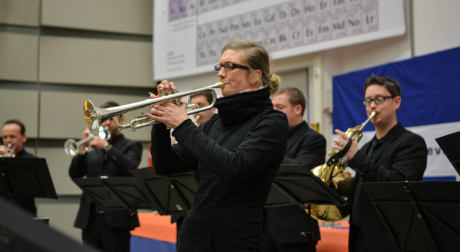
Photo: Brass ensemble Blechgewand(t) at the opening ceremony
After these plenary lectures that already demonstrated the broad range of topics to be discussed during the conference, the accompanying exhibition was opened for the welcome reception. This evening event already created a very stimulating environment for meeting with colleagues from all over the world, chatting with old friends or making new ones. The organizers motivated all participants to take some fresh air outside the conference halls by watching an impressive fireworks that marked the 30th anniversary of the conference.
During the next four days, the dense scientific program that was organized in four streams and included vendor seminars and poster sessions. The four streams program was framed by plenary lectures at the beginning and the end of each day, discussing some major topics related to plasma spectrochemistry. Each stream was initiated by a keynote lecture.

Photo: Annemie Bogaerts presenting
a plenary lecture on ICP-MS modeling
|
The first full day on Monday started with the plenary lecture by Annemie Bogaerts from the University of Antwerp. She gave an overview about recent progress and future prospects in ICP-MS modeling.
During Monday morning than the participants joined one of the four sessions devoted to Speciation Analysis, Nanoparticles, Fundamentals or Metallomics. The sessions were interrupted by coffee and lunch breaks, vendor seminars and a poster session with about 90 posters that discussed the same topics as the main sessions. The four streams were nicely synchronized and coffee breaks gave the opportunity to meet with colleagues, exhibitors and to discuss posters, future projects or simply the nice weather that encouraged participants to change between the two buildings of the conference or to walk the short way to the mensa for the lunch break. Since coffee and refreshments were offered the whole day through, any individual break could be used to visit the exhibition or the posters or to meet with others.
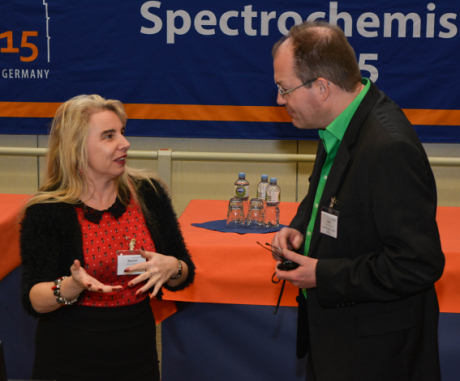
Photo: Joanna Szpunar together with the chairman Uwe Karst
The scientific program ended with a plenary lecture by Joanna Szpunar from Pau who reported about the state-of-the-art of "ICP-MS in Metallomics".
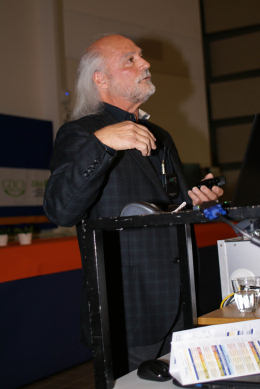
Photo: Rick Russo during his plenary
lecture devopted to laser ablation
|
Immediately after the last lecture, busses were waiting already to
transfer participants to the Zoo, a very special place to have dinner.
The whole zoo was open to the participants the evening and guided tours
highlighted certain sections of the zoo with a bar in the elephant house
where drinks where served. A buffet was waiting in the main building
and different bars where serving drinks, so that all participants had
ample time to enjoy the dinner as well as the different parts of the zoo
and short walks inbetween opened opportunities to meet with many
participants during the evening. More than half of all participants
joined for this special event, and those who did will certainly remember
it as a very special experience.
The third day (Thuesday) started with a plenary lecture by Rick Russo who gave an overview on the use of laser ablation for multielement analysis. The following four stream program focused on "Laser Ablation", "Metrology", "Isotopes" and applications related to "Energy & Fuels".
The afternoon ended with a special session devoted to the European award for plasma spectrochemistry. The award sponsored by Agilent technologies meant to promote analytical plasma spectrochemical developments and applications in Europe was received by Jörg Feldmann from the University of Aberdeen. In his lecture entitled "Arsenolipids - the Wolf in Sheep Clothing ?", he reported about the knowledge about arsenolipids with respect to occurrence in marine organisms, their distribution and toxicity.
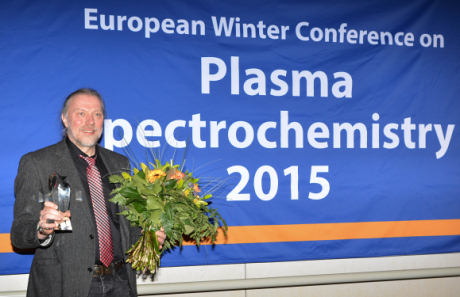
Photo: The 2015 European Plasma Award winner Joerg Feldmann
Again, immediately after the lecture busses were waiting for the participants to transfer them into the city center for a guided city tour. For the rest of the evening, some exhibitors had invited their costumers for dinner into different locations in the city. Participants could select between typical places in Münster such as the LWL Museum (Agilent), the brewery “Pinkus Müller” (Shimadzu), the Open-Air Museum Muehlenhof (Thermo) or the "Grosser Kiepenkerl" (Meinhard/ESI).
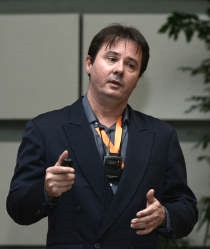
Photo: Philip Doble during his plenary lecture
|
The fourth day (Wednesday) scientific program started with a plenary lecture given by Maria Montes-Bayon from Oviedo. She reported about the possibilities to use plasma mass spectrometry as a tool in cancer studies. The following four stream program continued some topics from the day before, namely "speciation" and "nanoparticles" and introduced two new topics, namely "Instrumentation" and "environmental analysis". All four streams were initiated by keynote lectures in the morning and afternoon with prominent speakers (Joe Caruso and Naoki Furuta for the speciation session, Francisco Laborda for "Nanoparticles", Carla Vogt (Bioimaging), Alexander Gundlach-Graham (Instrumentation), Simon Chenery (Sample Introduction), Holger Hintelmann and Olivier Donard (Environment). The end of the day plenary lecture was presented by Philip Doble from the University of Technology Sydney who reported about "trends in bioimaging".
After such a long working day the social program for the evening was highly appreciated. Again busses were waiting to transfer participants to the "Uferlos", a location at the Aa Lake in Münster for the "Hot plasma party". The party took place at two floors with a buffet style dinner followed by dancing with life music. More than 450 participants joined this event, which lasted until the early morning.
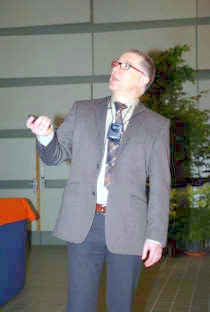
Photo: Frank Vanhaecke
|
Despite the fact that the party lasted until early in the morning, the attendees of the conference joined again next day early for the last half day of scientific program. Frank Vanhacke from the University of Ghent attracted the participants with his plenary lecure devoted to "ICP – mass spectrometry as an emerging tool for medical diagnosis".
Again the four stream program offered attractive topics such as "metallomics", "nanoparticles", "Instrumentation" and "glow discharges". The final plenary lecture was given By Jacob Shelley from Kent State University who gave an overview on "Atmospheric-Pressure Plasmas for Biological, Molecular, and Atomic Mass Spectrometry".
At the end of the scientific program Co-chair Michael Sperling recognized the poster presentations that were discussed during three poster sessions and significantly contributed with more than 260 posters to the attractive scientific program. From each poster session the best three posters were selected by an international poster jury for a poster award. The winners of the Monday poster session were Monika Winkler from the TU Graz, Talke Marschall from the University of Potsdam and Bastian Franze from the University of Münster. The winners of the second poster session were Andreas Zitek from the University of Natural Resources and Life Sciences, BOKU Vienna, Marcia F. Mesko from the Federal University of Pelotas, Brazil, and Silvia Queipo from the University of Oviedo. The winners of the last poster session were Tim Elseberg from the University of Muenster, Christine Opper from the University of Natural Resources and Life Sciences, BOKU
Vienna and Karen Murphy from the National Institute of Standards and
Technology (NIST).
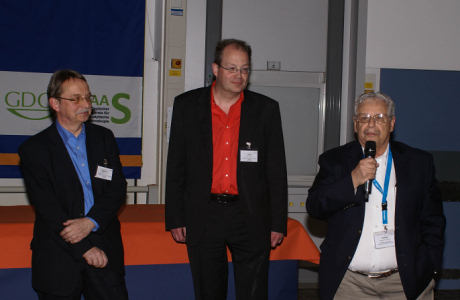
Photo: Co-chair Michael Sperling, Chair Uwe Karst and Joe Caruso
Before the organizers closed the conference the chairman of the next conference Thomas Prohaska was given the opportunity to introduce the place for the next conference in 2017 which is St. Anton in Austria. At the end Joe Caruso, as one of the former organizer of the conference, rose to speak in thanking the local organizers and the whole team for the excellent organization of the conference.
The conference ended with a farewell reception that offered the possibility to say good bye to old and new friends and to start the journey homewards after some refreshments.
 Related information:
Related information: EWCPS 2015 Homepage
EWCPS 2015 Homepage